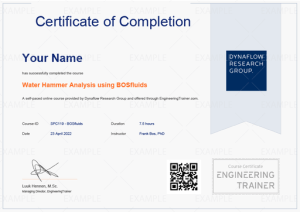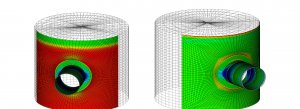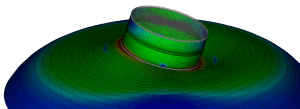
PV-Elite
Training Courses PV-Elite About The Course Whether you are designing a pressure vessel according to the ASME VIII, PD5500 or EN 13445, PV-Elite offers you
Unlock the world of ASME Boiler & Pressure Vessel Section VIII vessel design, the most globally recognized pressure vessel design code. This comprehensive course focuses on the Design by Analysis approach found in ASME VIII-2 Part 5, which complements the Design by Rules sections of the code.
Discover why Design by Analysis is essential. Explore scenarios where features are positioned near discontinuities, non-standard configurations exist, detailed fatigue calculations are required, or non-pressure loadings are at play. Learn to conduct code compliance checks for rupture, ratcheting, fatigue, and buckling load cases.
Delve into critical topics, including distinguishing between primary and secondary stresses, assessing the impact of weld types on fatigue life, and obtaining structural stress using Finite Element Analysis (FEM) software. This course is available in self-paced, E-hybrid, and classroom formats consisting of five modules.
All training materials are accessible through your EngineeringTrainer account, and upon course completion, you’ll enjoy one year of unlimited access for knowledge reinforcement and application in your projects.
Welcome & Your Instructors
Content Overview
How to use this course
Personal Certificate Requirements
Introduction and Agenda
ASME VIII-2 Chapter 5 ”Design by Analysis”
Failure model evaluated in Chapter 5
Code revisions of Section VIII division 2
Stress values from FEA
Focus of the course
Introduction and Agenda
Evaluating Plastic Collapse 3 Methods
Method 1 Elastic analysis
Method 2 Limit load analysis
Method 3 Elastic-plastic analysis
Comparing 3 methods against Plastic Collapse
Stress linearization of FEA results
What is ratcheting? An introduction
Compliance check for ratcheting failure
Simplified elastic/plastic analysis method
Elastic/plastic analysis method
Fatigue failure and micro cracks
Analysing fatigue Assessment methods
Method A: Smooth bar method
Method B: Welded curve method
Evaluating local failure & compliance checks
Evaluating buckling & compliance checks
Congratulations
Course evaluation survey
Your Personal Certificate
Rate this course
Related resources & follow up
Self-Paced
This course is self-paced and is not subject to specific dates. The course contains 5 modules with a total of 3 hours of content which can be performed at your own pace. A personal certificate will be provided to you if you finish the course within the first month after purchase. This incentive aims to motivate you to perform the course on time, thereby improving your learning curve.
E-Hybrid
This course is scheduled regularly with a drip feed of modules becoming available to the participants throughout the program. The drip schedule aims to provide consistency to your learning experience and is designed to maintain participant concentration and provide adequate time to perform exercises between live instructor sessions where the instructor may answer any questions about the topic.
This course type is also available for a private schedule for teams of a minimum of 4 people.
Spring Program:
Fall Program:
Classroom
This course is scheduled over 1 work day. The dates of the course are organized upon inquiry.
This course is available in self-paced, hybrid, and classroom formats.
Prerequisites and level
Intended For
This course is designed for:
Access to the self-paced course
After your purchase is confirmed you receive an account to the EngineeringTrainer online learning portal, where you can find the course in your dashboard. After opening the course you will be guided step-by-step through the different modules. You receive 1-year unlimited access to the course, allowing for the repetition of modules as desired.
Access to the hybrid course
After your purchase is confirmed you will see the course in your EngineeringTrainer.com dashboard. Here you find the course welcome chapter and instructions on how to join the live sessions.
The relevant items of the course, including the links for the live sessions, are provided through a drip schedule, meaning that modules will become available step-by-step as the course progresses. Some weeks include self-paced learning modules, others both self-paced as live events as per the program.
After the course you receive 1-year unlimited access to all course material including recordings of the live sessions. This allows you to watch recording of lectures again whenever you need to refresh knowledge for your daily work projects.
Learn by doing
The course utilizes pre-recorded lectures and self-study exercises, combined with live Q&A’s and discussions. Live events are provided through MS Teams for which links are distributed from your course dashboard. Note that no downloadable manual is provided in this course as it is completely provided through the Engineering Trainer’s interactive portal.
You receive 1-year unlimited access to the course. This allows you to perform modules again when you need to refresh your knowledge for your work projects.
Participants of the self-paced and E-hybrid courses receive a personal digital certificate if they meet the following requirements:
Participants of the classroom course receive a personal physical certificate upon the completion of the course.
Example certificate:

After this course, participants are expected to:
Video lectures,
Instructor-led live sessions with lectures, group discussions and Q&A’s,
Discussion forum with other participants & instructor.
Videos will not be available for download, but can be accessed directly with your account on the portal. If slides are used in the videos or live sessions these can be viewed separately as well through the portal, but are not available for download.
You receive 1-year unlimited access to the course. This allows you to watch content again if this is beneficial for your work projects.
Yes, live sessions are included in this course that allow you to interact with the instructor and ask questions. Additionally, questions can be submitted in the learning portal by the participants which are addressed in the live sessions.
No software is required for participants of this course.
Self-paced Modules
If your computer and internet connection are able to play videos online and have MS Teams calls you will be able to follow the course. Note that almost all browsers are supported, except for Internet Explorer.
Live sessions
Live events are provided by means of Microsoft Teams. Hence it required to have an MS Teams account. Additionally, a webcam and microphone are mandatory for the live events. Separate earplugs are recommended as to avoid sound echo.
Yes, this course qualifies for PDH hours as per the NCEES CPC Guidelines.

Training Courses PV-Elite About The Course Whether you are designing a pressure vessel according to the ASME VIII, PD5500 or EN 13445, PV-Elite offers you

Training Courses NozzlePRO Essentials Download Brochure About The Course This self-paced course teaches you all the fundamentals, and much more, about working with NozzlePRO. Not

Training Courses FEPipe Essentials Download Brochure About The Course Enhance your proficiency with FEPipe software through a comprehensive training program. Suitable for both new and
Phone: +31 (0)85 058 0046
E-mail: infoaanvraag@dynaflow.com
Laan van Oversteen 20
6th floor
2289 CX Rijswijk
The Netherlands
© Dynaflow Research Group BV